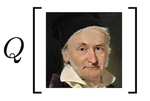Compressed Sensing
Compressive Schlieren Deflectometry
Abstract: Schlieren deflectometry aims at characterizing the deflections undergone by refracted incident light rays at any surface point of a transparent object. For smooth surfaces, each surface location is actually associated with a sparse deflection map (or spectrum).
Robust 1-Bit Compressive Sensing via Binary Stable Embeddings of Sparse Vectors
Abstract: The Compressive Sensing (CS) framework aims to ease the burden on analog-to-digital converters (ADCs) by reducing the sampling rate required to acquire and stably recover sparse signals. Practical ADCs not only sample but also quantize each measurement to a finite number of bits; moreover, there is an inverse relationship between the achievable sampling rate and the bit-depth.
Stabilizing Nonuniformly Quantized Compressed Sensing with Scalar Companders
Abstract: This paper studies the problem of reconstructing sparse or compressible signals from compressed sensing measurements that have undergone nonuniform quantization. Previous approaches to this Quantized Compressed Sensing (QCS) problem based on Gaussian models (bounded l2-norm) for the quantization distortion yield results that, while often acceptable, may not be fully consistent: re-measurement and quantization of the reconstructed signal do not necessarily match the initial observations.
Compressed Sensing: When sparsity meets sampling
Remark: Chapter of the book “Optical and Digital Image Processing - Fundamentals and Applications”, Edited by G. Cristòbal; P. Schelkens; H. Thienpont. Wiley-VCH, April 2011. ISBN:978-3-527-40956-3. (website of the book)
Dequantizing Compressed Sensing: When Oversampling and Non-Gaussian Constraints Combine
Abstract: In this paper, we study the problem of recovering sparse or compressible signals from uniformly quantized measurements. We present a new class of convex optimization programs, or decoders, coined Basis Pursuit DeQuantizer of moment p (BPDQp), that model the quantization distortion more faithfully than the commonly used Basis Pursuit DeNoise (BPDN) program.
Some comments on Noiselets
jackdurden - Aug 5, 2010
It could be doable indeed. I feel more confortable with SS than with randperm nevertheless. But I saw some concentration results on random permutations recently on arxiv that could help.
Some comments on Noiselets
Recently, a friend of mine asked me few questions about Noiselets for Compressed Sensing applications, i.e., in order to create efficient sensing matrices incoherent with signal which are sparse in the Haar/Daubechies wavelet basis.
Quantized sub-Gaussian random matrices are still RIP!
I have always been intrigued by the fact that, in Compressed Sensing (CS), beyond Gaussian random matrices, a couple of other unstructured random matrices respecting, with high probability (whp), the Restricted Isometry Property (RIP) look like “quantized” version of the Gaussian case, i.
